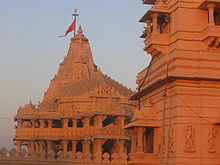Somnath Temple

The Somnath Temple ( Gujarati : સોમનાથ મંદિર) in the place of the same name near Veraval in Saurashtra , on the west coast of Gujarat , India , is considered the holiest of the twelve Jyotirlinga shrines of the god Shiva . Somnath means: "Protector of the moon god". The temple was destroyed six times and rebuilt just as often, most recently from 1950 to 1953 after India gained independence.
history
The first temple at Somnath is said to date from the time before the birth of Christ. The second, built by the Yadava dynasty of Vallabhi , replaced it around 649. In 725 Junayad, the Arab governor of Sindh, had it destroyed. King Nagabhata II of Gujarat had the third temple built in 815.
Another destruction took place in 1024 by Mahmud of Ghazni , who received much praise for it in the Islamic world. A new reconstruction took place 1026-1042, followed by the renewed destruction in 1297 by the army of Sultan Allauddin Khilji.
Mahipala Deva, King of Saurashtra had the sanctuary rebuilt in 1308, Muzaffar Shah I, Sultan of Gujarat had it destroyed again in 1394. Further destruction took place in 1413, 1451 and 1469, the latter by the Mughal emperor Aurangzeb . Aurangzeb had a mosque built in its place using material from the temple, but it was hardly in use or function in the following years. The Marathi queen Ahilyabai Holkar of Indore had a new temple built next to this mosque in 1783. From 1812 the region was again under the rule of Muslim rulers, most recently at the time of British India by the Nawabs of Junagadh .
After India gained independence, the first Indian interior minister and leading congress politician, Vallabhbhai Patel , a native of Gujarati, visited Junagadh and announced the rebuilding of the temple in a speech on November 12, 1947, the day of the Hindu festival of Diwali . This began on May 8, 1950. The mosque was moved a few kilometers. Prime Minister Jawaharlal Nehru disapproved of this act of Hindu activism. There was no significant protest from the Muslim side as the site was not considered sacred by the Muslims.
literature
-
Christophe Jaffrelot : Le nationalistes hindoues . Presses de Sciences Po, Paris 1992.
- English translation: The Hindu Nationalist Movement and Indian Politics. 1925 to the 1990s . Penguin Books India, New Delhi 1999, ISBN 0-14-024602-9 (EA New York 1996).
- Peter van der Veer : Ayodhya and Somnath, Eternal Shrines, Contested Histories. In: Social Research. An International Quarterly , Vol. 59 (1992), Issue 1, pp. 85ff. ISSN 0037-783X
Web links
- Official website
- Somath Jyotirlinga
- Link catalog on the topic of Temple Somnath at curlie.org (formerly DMOZ )
Individual evidence
- ↑ Ghazni sacks Somnath Temple. on: indhistory.com
- ↑ Somanatha and Mahmud. ( Memento of the original from April 21, 2012 on WebCite ) Info: The archive link was automatically inserted and not yet checked. Please check the original and archive link according to the instructions and then remove this notice. on: flonnet.com
- ↑ a b c Leaves from the past. (No longer available online.) Archived from the original on January 10, 2007 ; accessed on February 15, 2011 (deleted link (March 6, 2015)). Info: The archive link was inserted automatically and has not yet been checked. Please check the original and archive link according to the instructions and then remove this notice.
- ↑ a b c d e van der Veer, Peter: Ayodhya and Somnath: Eternal Shrines, Contested Histories. Social Research 59 (1): 85-109 (1992). JSTOR 40970685
- ^ Somnath Temple. In: Official Gujarat State Portal.
- ^ Somnath History. ( Memento of the original from July 14, 2011 in the Internet Archive ) Info: The archive link was inserted automatically and has not yet been checked. Please check the original and archive link according to the instructions and then remove this notice. on: meriyatrra.com
Coordinates: 20 ° 53 ′ 16.7 " N , 70 ° 24 ′ 4" E
